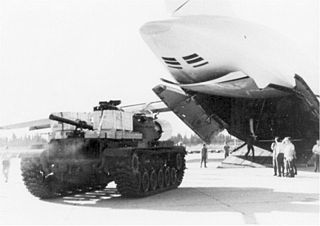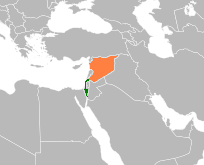Related Research Articles

The Yom Kippur War, Ramadan War, or October War, also known as the 1973 Arab–Israeli War, was fought from October 6 to 25, 1973, by a coalition of Arab states led by Egypt and Syria against Israel. The war took place mostly in Sinai and the Golan—occupied by Israel during the 1967 Six-Day War—with some fighting in African Egypt and northern Israel. Egypt's initial war objective was to use its military to seize a foothold on the east bank of the Suez Canal and use this to negotiate the return of the rest of Sinai.
The history of the Israel Defense Forces (IDF) intertwines in its early stages with history of the Haganah.

David "Dado" Elazar was the ninth Chief of Staff of the Israel Defense Forces (IDF), serving in that capacity from 1972 to 1974. He was forced to resign in the aftermath of the Yom Kippur War.

Avigdor "Yanush" Ben-Gal was an Israeli general.

Operation Nickel Grass was a strategic airlift operation conducted by the United States to deliver weapons and supplies to Israel during the 1973 Yom Kippur War. In a series of events that took place over 32 days, the U.S. Air Force's Military Airlift Command shipped 22,325 tons of tanks, artillery, ammunition, and supplies in C-141 Starlifter and C-5 Galaxy transport aircraft between 14 October and 14 November 1973. The U.S. support helped ensure that Israel survived a coordinated and surprise attack from the Soviet-backed Arab Republic of Egypt and Syrian Arab Republic.

Kippur (כיפור) is a 2000 Israeli drama war film directed by Amos Gitai. The storyline was conceived from a screenplay written by Gitai and Marie-Jose Sanselme; based on Gitai's own experiences as a member of a helicopter rescue crew during the 1973 Yom Kippur War. The film stars actors Liron Levo, Tomer Russo and Uri Klauzner in principal roles.

Aluf (res.) Yossi Ben Hanan was born in Jerusalem, Israel, in 1945. His father, Michael Ben Hanan served as one of the top commanders, (Haganah) in Jerusalem.

The 7th Mechanized Division is a division of the Syrian Arab Army, currently engaged in the Syrian Civil War.
Golan is a board game simulating operational level ground combat between Israel and Syria on the Golan Heights during the 1973 Arab-Israeli War. The game is an introductory level product with an emphasis on playability over simulation value.
The Battle of the Sinai was one of the most consequential battles of the Yom Kippur war. An Egyptian attacking force that advanced beyond their line of defense at the Bar-Lev Line was repulsed with heavy losses by Israeli forces. This prompted the Israelis to launch Operation Abiray-Lev the next day, penetrating the Egyptian line of defense and crossing the Suez Canal.

Ori Orr is an Israeli retired general and politician. During his service with the Israel Defense Forces, he headed the Central and Northern Commands. Afterward, he was elected to the Knesset twice for the Labor Party. He chaired the Foreign Affairs and Defence Committee and was appointed Deputy Minister of Defence.

Israel–Syria relations refers to bilateral ties between Israel and Syria. The two countries have since the establishment of the State of Israel been in a state of war. The countries have fought three major wars, which are the 1948 Arab Israeli War in 1948, the Six-Day War in 1967, and the Yom Kippur War in 1973, later also being involved in the Lebanese Civil War and the 1982 Lebanon War, as well as the War of Attrition. At other times armistice arrangements have been in place. Efforts have been made from time to time to achieve peace between the neighbouring states, without success. Syria has never recognised the State of Israel and does not accept Israeli passports for entry into Syria. Israel also has regarded Syria as an enemy state and generally prohibits its citizens from going there. There have not been diplomatic relations between the two countries since the creation of both countries in the mid-20th century.

Before the Six-Day War and Yom Kippur War, the Golan Heights comprised 312 inhabited areas, including 2 towns, 163 villages, and 108 farms. In 1966, the Syrian population of the Golan Heights was estimated at 147,613. Israel seized about 70% of the Golan Heights in the closing stages of the Six-Day War. Many of these residents fled during the fighting, or were driven out by the Israeli army, and some were evacuated by the Syrian army. A cease-fire line was established and large parts of the region came under Israeli military control, including the town of Quneitra, about 139 villages and 61 farms. Of these, the Census of Population 1967 conducted by the Israeli Defence Forces listed only eight, including Quneitra. One of the remaining populated villages, Shayta, was partially destroyed in 1967 and a military post built in its place. Between 1971–72 it was destroyed completely, with the remaining population forcibly transferred to Mas'ade, another of the populated villages under Israeli control.
Events in the year 1973 in Israel.

The 1973 Syrian General Staff Headquarters Raid was an aerial strike carried out by the Israeli Air Force on October 9, 1973, the fourth day of the Yom Kippur War. Following a strike by Syrian surface-to-surface missiles against settlements and installations in northern Israel, seven F-4 Phantom IIs from 119 Squadron attacked the Syrian General Staff Headquarters (GHQ) and adjacent buildings in downtown Damascus.

The 1st Armoured Division is a division of the Syrian Arab Army. It was established before 1973.

The Agreement on Disengagement is an agreement between Israel and Syria that was signed on May 31, 1974, which officially ended the Yom Kippur War and the subsequent attrition period on the Syrian front.

This article deals with the history and development of tanks of the Israeli Army, from their first use after World War II in the establishment of the State of Israel after the end of the British Mandate, and into the Cold War and what today is considered the modern era.

The Bashan Salient was a territory in Southwestern Syria which was conquered by the Israeli Army during the 1973 Yom Kippur War. The salient was about twenty kilometres wide and encompassed an area of approximately 400km2, extending to a point 33 kilometres from the Syrian capital of Damascus. The Salient was evacuated by the Israeli army shortly after the signing of a disengagement agreement between the Israeli and Syrian forces on May 31, 1974. The Salient included the summit of Mount Hermon, the town of Beit Jinn, and many other Syrian villages.
References
- Dunstan, Simon (2003). The Yom Kippur War 1973. Osprey Publishing. ISBN 1-84176-220-2.